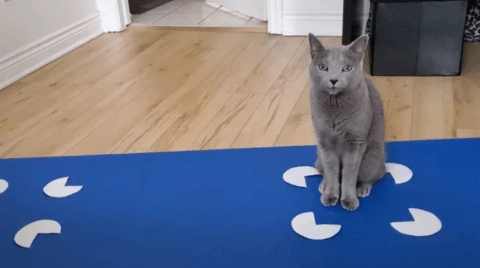
Most cat carers will have experienced a time where they have brought in a box and before they know it, their cat is investigating it, and even sitting in it. But what is it about boxes that send our feline friends into a frenzy? Is it a quirk in their character or perhaps a deeper reason behind it? Why do cats love boxes?
There are a number of theories put forward as to why cats may like interacting with and or sitting/laying in boxes. Some of these include:
- A sense of safety and security: Cats are both predators and prey animals. In the wild, having a hidden vantage point can be a life-saving advantage. Boxes offer cats a ‘safe’ confined space where they can observe their surroundings without being seen. This provides them with a sense of security and, consequently, likely reduces stress.
- Temperature regulation: Boxes are typically made of cardboard which makes for great insulation. Cats have a higher body temperature than humans and prefer warmer environments – this is why cats will happily snooze in a sunbeam. It is thought that the insulating properties of cardboard can help cats maintain their warm temperature, and provide a cosy resting place.
- Texture: Cardboard is also great for scratching. The texture can help cats keep their claws sharp and gives them something to knead, which can be comforting for our four-legged friends. This is why you will often see scratching mats and similar made from cardboard.
- Curiosity: Cats are innately curious; a new box in their environment can represent a novel challenge, interest or mystery. Cats, typically, enjoy exploring new spaces so a box is a simple and accessible way for carers to provide some enrichment, especially by hiding tit-bits in there from food stuffs and cat chews to feathers and other feline-friendly items, to satisfy curious minds.

The Illusory Box Experiment
In 2021, Gabriella Smith and colleagues, wanted to understand more about cats’ inclination towards boxes, even if boxes are not physically present. The team set up the Kanizsa Square Illusion, which uses partial shapes to create the appearance of a square. The experiment aimed to understand if cats would recognise and be attracted to this illusory square in the same way they are attracted to real boxes.
The results indicated that cats did indeed respond to the Kanizsa Square Illusion. They chose to sit within the illusory square just as they would a tangible box. The findings indicated cats might be guided by the visual cues of boxes as much as their tactile and spatial properties, revealing a fascinating aspect of feline cognition and perception (Smith et al., 2021).
Pro tips for cat carers
If you are a cat owner or carer, you can leverage this love of boxes to make your cat’s life even better. Here are some tips:
- Playtime: Use boxes as toys. Hide treats or toys inside and let your cat “hunt” for them. Cats love to forage and you can draw out their love of hunting with boxes. This includes using dangle/rod toys from the top or cut out holes to create a makeshift whack-a-mole game. Never leave your cat alone with any toys, chews or boxes that may cause a choke or strangulation hazard.
- Resting spaces: Place soft blankets, cushions or something that smells of yourself like an old t-shirt inside larger boxes to create a cosy resting space. Cats love enclosed, warm spots, and a box can be a great addition to their favourite nap locations.
- Level up: Cats love to climb – it also helps them feel safe. You can stack boxes to create multi-level platforms; ensure they are secure to avoid any tumbling over. Higher resting spots gives your cat a new vantage point and also serves as a fun playground.
- Location, location, location: Place boxes near windows so your cat can peek outside while feeling safe and secure. This can be a great way for indoor cats to bird-watch and stay engaged with the outside world.
- Decorate: Make it fun! Paint the boxes, add strings, feathers, or even build a cardboard castle. This is a great way to involve any children at home and can be a fun DIY project that benefits both you, any children and your feline friend.
- Rotate: Just as with any other toy, cats might get bored with the same box after a while. Introduce new boxes from time to time to keep their interest piqued, and include different shapes, sizes, and heights. Make sure your cat can safely get in and out of any boxes; young or older cats may struggle with higher sided boxes, so you can cut down a side of the box or make exit holes big enough for your cats to move in and out easily.
Key takeaways
Cats’ love for boxes isn’t just a cute internet meme; it’s deeply rooted in their behaviour, physiology, and psychology. While it may seem like a simple piece of cardboard, to a cat, a box represents security, comfort, and entertainment. So, next time you get a package, think twice before tossing that box. It might just be your cat’s new favourite thing!
References
- Smith, G., Dale, R., & Schapiro, S. J. (2021). If I fits I sits: A citizen science investigation into illusory contour susceptibility in domestic cats (Felis catus). Applied Animal Behaviour Science, 237, 105277.
Learn more about our classes

Get Hanne's Book
Playing With Your Dog will help any dog owner work out the games that are best suited for their pet to play throughout his life, from puppyhood to old age. The book also shares some tricks for all ages, group activities, and recommended toys that dogs will enjoy.

























